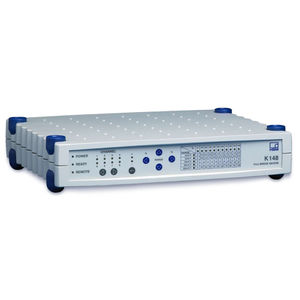
- Detection - Measurement
- Electrical Measurements
- Signal calibrator
- HBM Test and Measurement
- Company
- Products
- Catalogs
- News & Trends
- Exhibitions
Signal calibrator K3607 for strain gauge amplifiersreference valuehigh-precision
Add to favorites
Compare this product
Characteristics
- Physical quantity
- signal
- Applications
- for strain gauge amplifiers
- Options
- high-precision, reference value
Description
The K3607 calibration unit can be used to calibrate measuring amplifiers or measurement chains without imposing a mechanical quantity on the strain gage transducers belonging to the measurement chain.
The K3607 calibration unit can be used to calibrate measuring amplifiers or measurement chains without imposing a mechanical quantity on the strain gage transducers belonging to the measurement chain. For this purpose the calibration instrument is equipped with a high-precision resistance network in star configuration, designed to simulate 350-Ω strain gage full-bridge transducers. The extremely low self-capacitance and self-inductance of the inbuilt precision resistors place the calibration instrument in accuracy class 0.025. When an appropriate measuring amplifier is used, the K3607 calibration instrument can be operated in six-wire circuit for balancing the ohmic and capacitive effects of long measurement cables.
Key Features
Suitable for simulating output signals of 350ohm strain gage fullbridge transducers
30 calibration signals between 0.05mV/V and 10mV/V
Absolute zero point stability with equivalent star circuit
Suitable for transducers supplied with DC voltage and carrier frequency up to 5kHz
Mobile application for many measuring chains
Catalogs
K3607
2 Pages
Other HBM Test and Measurement products
Precision Amplifiers & Calibration Units
Related Searches
- Calibration system
- Precision calibration system
- Automatic calibration system
- Transducer
- High-precision calibration bench
- Standard calibration system
- Signal calibration bench
- Hydraulic calibration system
- Reference value calibration equipment
- Current output transducer
- Voltage output transducer
- Fully-automatic calibrator
- Load calibrator
- Strain gauge transducer
*Prices are pre-tax. They exclude delivery charges and customs duties and do not include additional charges for installation or activation options. Prices are indicative only and may vary by country, with changes to the cost of raw materials and exchange rates.



